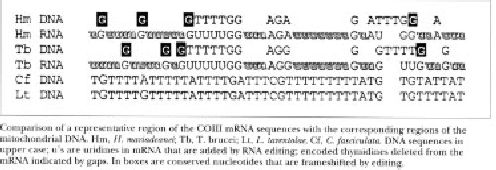
Joint Penn-UDel Seminar on DNA Computing
In Vitro Evolution of Complexity
Laura Landweber

Comparison of a representative region of the COIII mRNA sequences with the corresponding regions of the mitochondrial DNA. Hm, H. mariadeanei; Tb, T. brucei; Lt, L. tarentolae, Cf, C. fasciculata. DNA sequences in upper case; u's are uridines in mRNA that are added by RNA editing; encoded thymidines deleted from the mRNA indicated by gaps. In boxes are conserved nucleotides that are frameshifted by editing.
Other experiments I will describe survey the natural diversity of genetic
systems to draw inferences about which processes are primitive or derived.
These include RNA editing and gene scrambling, two forms of genetic
information processing which take place in kinetoplastid and ciliated
protozoa, respectively.
In vitro selection, or directed molecular evolution, allows the isolation
and amplification of rare sequences that satisfy a selection criterion. This
technique can be used to isolate novel ribozymes (RNA enzymes) from large
pools of random sequence. We have recently used in vitro evolution to
discover a ribozyme that catalyzes a novel template-directed RNA ligation.
This reaction is unusual in its preference for extensive base-pairing and the
requirement only 28 selected nucleotides for activity. Our results suggest
that similar small RNA ligase motifs can arise under fairly simple conditions,
which could have led to the production of longer and more complex RNA polymers
in prebiotic evolution.
Thursday, May 15, 1997 at 4pm in Room 317 the Towne Building, located at 220 South 33rd Street at the University of Pennsylvania.